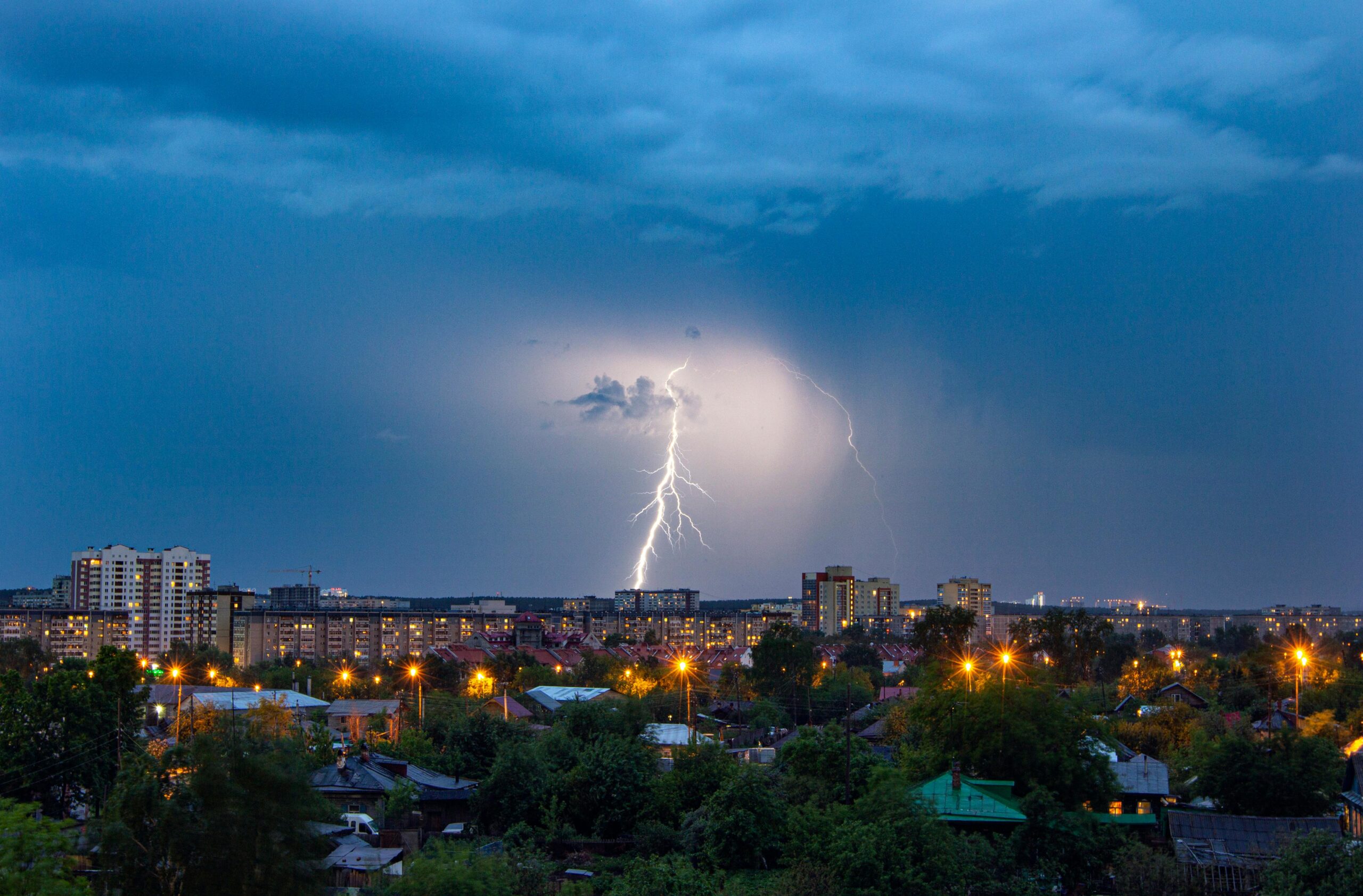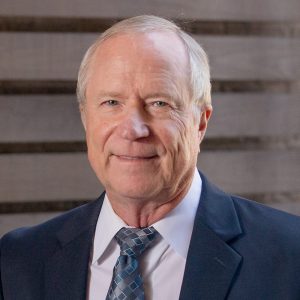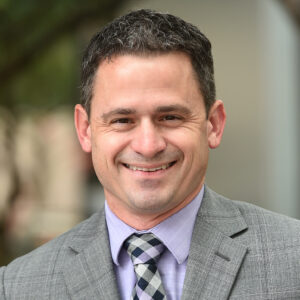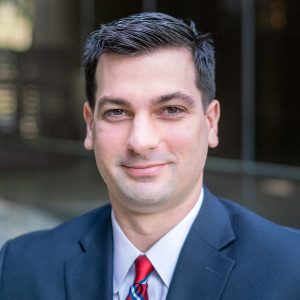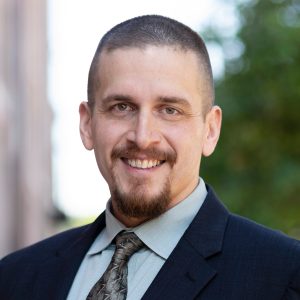Voltage surge describes a short-duration event when a system experiences a voltage that is higher than the nominal value, i.e., the normal operating voltage of a building’s electrical system. The amplitude of the overvoltage experienced could be as little as a few volts, or as much as thousands of volts above the nominal value. Damage due to surge events is becoming increasingly more common with changes in technology, changes in the types of electrical loads, and an overall increase in electrical components within the built environment. Surge protection devices (SPD) reduce the voltage surge caused by lightning strikes, power company grid switching, power line crossing, and power line short circuits. Surge events can enter the building through the service entrance conductors or other conductive materials.
In addition to these external sources, building electrical systems can also experience internally generated transient conditions. These minor amplitude voltage surges can cause slow degradation of electrical system components that may be more damaging than major external events and have the potential to lead to costly remediation. The risks can be reduced and the entire electrical system in a building can be protected with a cascading approach to surge protection. Cascading surge protection devices involve a device at the service entrance, as well as surge protection devices at panels throughout the building’s electrical distribution system.
Why Cascading Protection is Critical:
- A surge protection device at the electrical service entrance can protect against major voltage spikes caused by lightning strikes, grid switching, line crossing, or accidents. These events can be extremely destructive without protection.
- Secondary surge protection provides another layer of defense. Having surge protection with filtering on distribution and branch panels can dampen the destructive effects of major surges and prevent premature failure of equipment, infrastructure, and data loss. For critical or sensitive operations, having such protection with noise filtering or a series surge filter is the best solution to prevent potentially catastrophic, costly, and repetitive damage.
- Let Through Voltage: While most energy from a major surge event will be diverted away from the facility by the SPD at the entrance, some residual voltage may be able to pass through into the facility. Having smaller SPDs with filtering (UL 1283, EMI filter) at the distribution and branch panels will supplement the service entrance protection by eliminating the higher frequency surges that would otherwise travel directly from the entrance to the equipment.
- Internally Generated Surges: The number of internal disruptive sources continues to grow with the added uses of Variable Frequency Drives (VFDs) and LED lighting. In addition, surge protection coordination has become even more critical with the increasing use of non-linear (switching) power supplies which are found in all types of electronic components. Even computer monitors and laptop computers can cause damaging harmonics in an electrical system. It is typically not the device itself that is damaged when the harmonic distortions are generated, but other equipment connected to the same voltage source. The sensitivity of modern microprocessors to voltage disruptions increases the need to mitigate and dampen internally generated power distortions. Cascading surge protection with filtering throughout a facility can limit the harmful effects of these conditions.
Selection and Specification of Surge Protection Devices:
Following are some key considerations to be aware of when specifying SPDs.
- VPR (Voltage Protection Rating): VPR is a measure of how well the SPD can clamp down on a surge by letting as little voltage surge as possible pass through during an event. For source voltages of the same value, the lower the VPR number, the better rating a unit has. Surge events can be either a current event or a voltage event. In the case of a voltage event, the surge can propagate, practically unattenuated, to the end of a branch circuit when no low-impedance load or local SPD is present along the branch circuit. Better VPR ratings make a cascade of surge protection equipment more effective at controlling voltage events.
- Computer Matched MOVs: Metal Oxide Varistors (MOV) are two-pin electronic devices that are grouped together to shunt a surge to ground. This creates a surge device that will share the load equally and result in true surge protection capabilities.
- Third-Party Testing: UL does not provide performance testing or actual surge testing. They only test the VPRs and overall safety, so it is imperative a third party confirms compliance with the published ratings.
- Life Cycle Testing: This is required to test the robustness of the unit. This will show how many strikes it can survive without degrading.
- Matching KA Per Mode/Phase: It is imperative to match the proper kilo ampere (KA) maximum current rating to the bus rating and location.
Surge protection is a critical component of electrical power distribution systems in modern buildings. These devices can prevent costly damage to electrical infrastructure and to sensitive electronic equipment. A properly designed cascading system of surge protection devices can limit the risk from major power surges as well as internally generated harmonics.
The following references from NFPA Standards provide specific requirements for the application of surge protection devices.
NFPA 780 – 2023
4.19.2.1 SPDs shall be Installed at all power service entrances.
4.19.2.2 All points where a cable enters/leaves a building to supply another building, or cable runs over 100ft.
4.19.2.3 Permitted to be installed anywhere on the load side of service disconnect or at the point of utilization on the load side of a branch circuit overcurrent protection device up to the equipment served. (Not required, but recommended by IEEE 62.71 Cascading SPDs)
4.19.4.1 All signal, data, and communications system conductors or cables that enter/exit a building or supply equipment.
4.19.5.1 SPDs shall be installed for all communication systems (including, but not limited to, CATV, alarm, and data) and antenna systems at facility entrances.
4.19.6.1 Installation shall conform to NFPA 70.
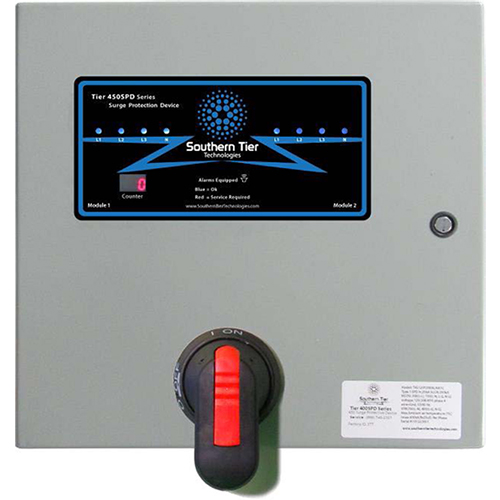
STT 450 Series 400kA and Larger
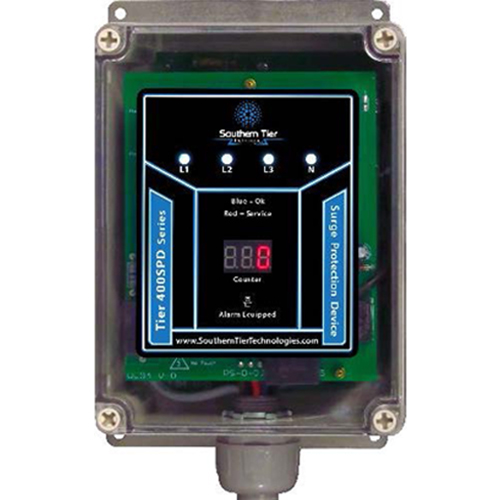
STT 450 Series Non-modular Wire Lead
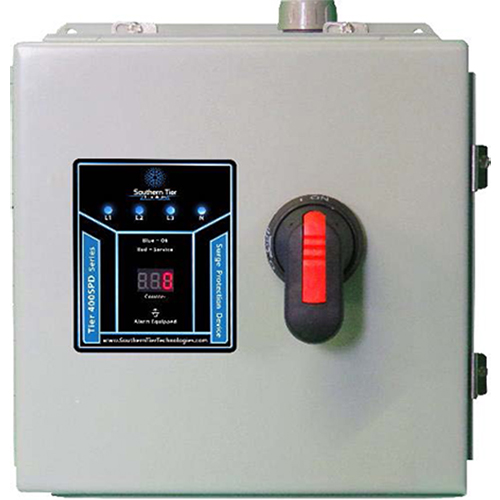
STT Modular Disconnect
NEC – NFPA 70 – 2023
242.12 – 242.14 Service Entrance/Disconnect – SPDs shall be installed, in either Type 1 (On Supply, or Load Side) or Type 2 (On Load Side) configuration, at the Service Disconnect.
242.16 Type 3 SPDs – Type 3 SPDs are Permitted on the load side of branch circuits, up to the equipment served. (Not required, but recommended by IEEE 62.71 Cascading SPDs)
501.35 (A) & (B) Class I Locations – SPD Shall be installed in Class I Division 1 and 2 Locations (Where Fire and Explosion hazards may exist due to flammable gases or vapors or flammable liquids.)
502.35 Class II Locations – SPD Shall be installed in Class II Division 1 and 2 Locations (Where Fire and Explosion hazards may exist due to combustible dust.)
517.26 Healthcare Facilities – The Life Safety Branch must meet requirements of Article 700 (requires SPDs).
620.51 (E) Elevators /Escalators – Where disconnecting means supplying an emergency load, legally required system load, or a critical operation power system load, listed surge protection shall be provided.
645.18 IT/Data Systems – SPDs shall be provided for critical operations data systems.
670.6 Industrial Machinery – Industrial machinery with safety interlock control devices not effectively protected from voltage surges on the incoming supply circuit shall have surge protection installed.
695.15 Fire Pumps SPD – Shall be installed in or on the Fire Pump Controller.
700.8 Emergency Systems – SPDs shall be installed in/on all emergency systems switchboards and panelboards.
708.20 (D) Critical Operations Power Systems – SPDs shall be provided at all facility distribution voltage levels.
